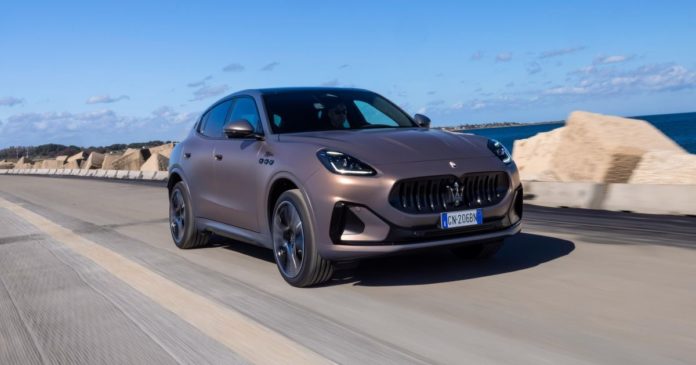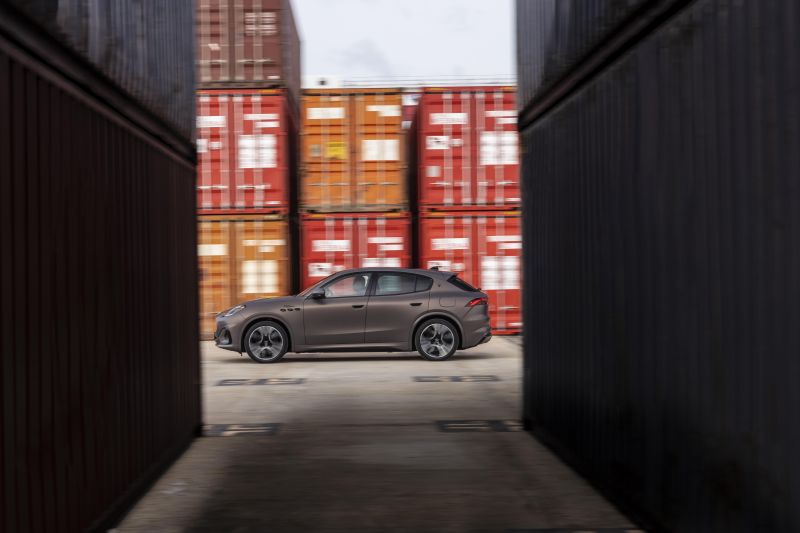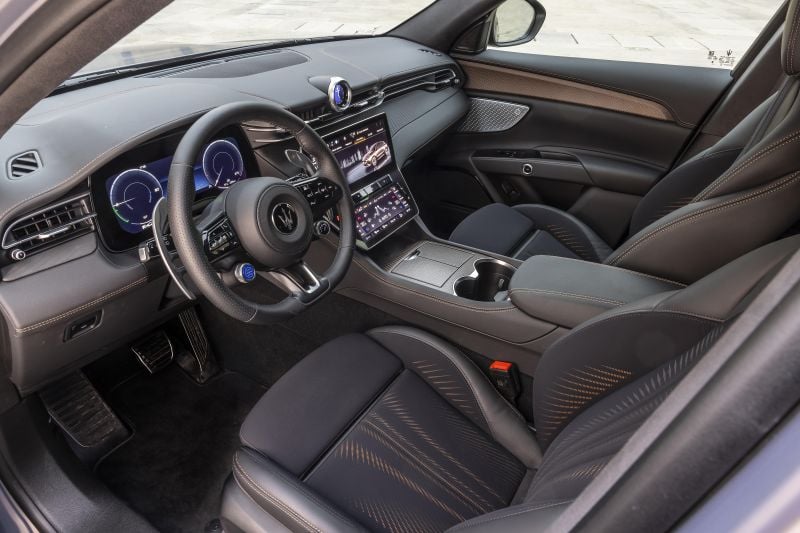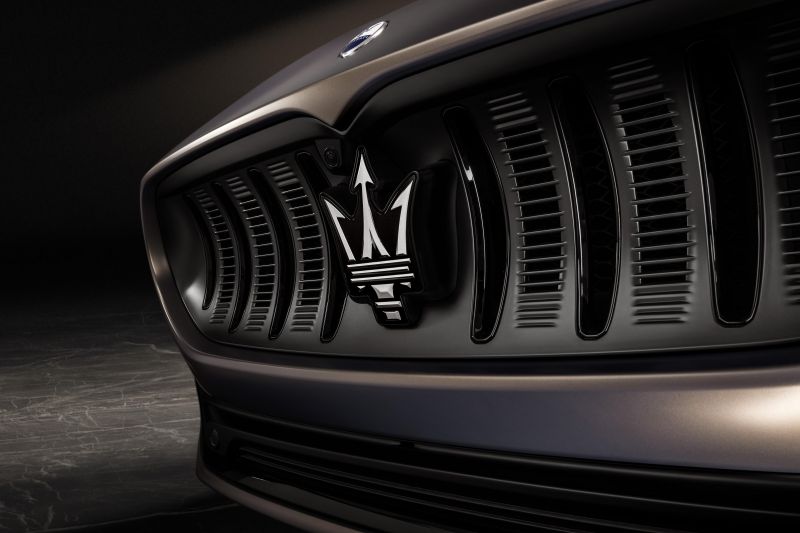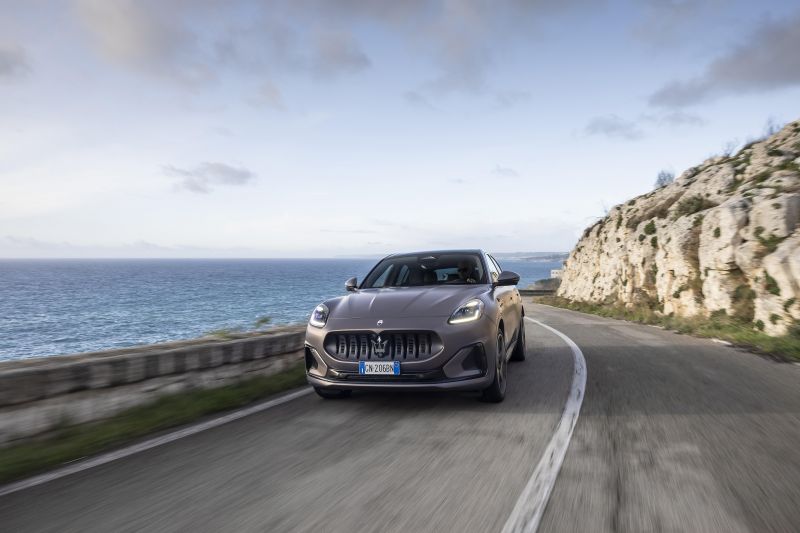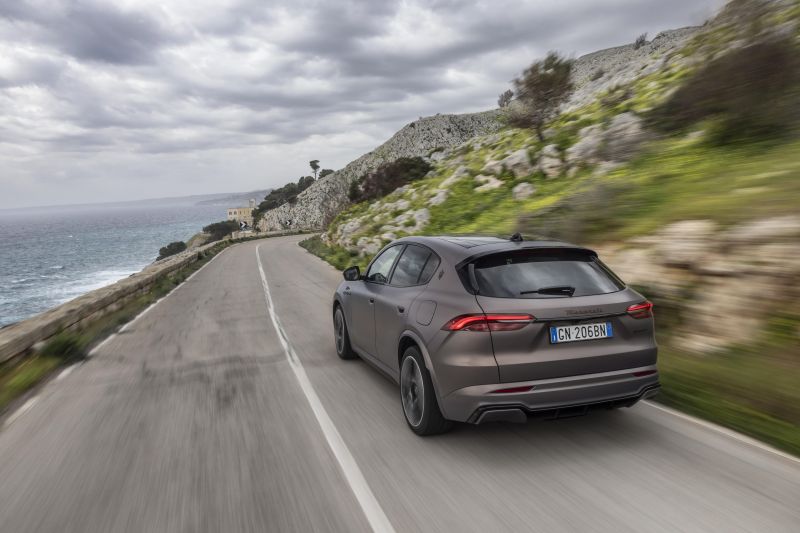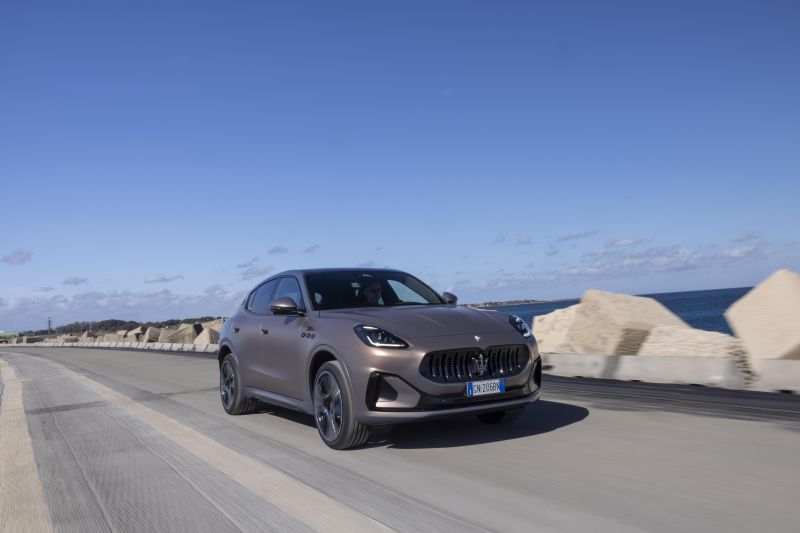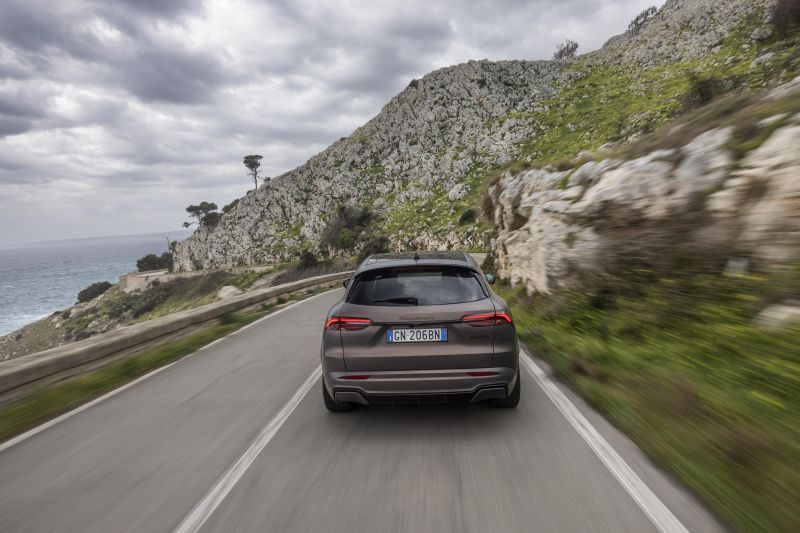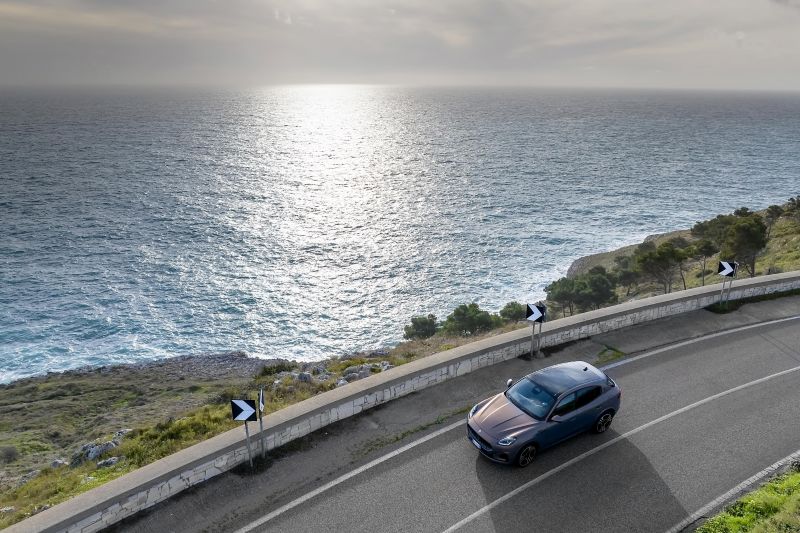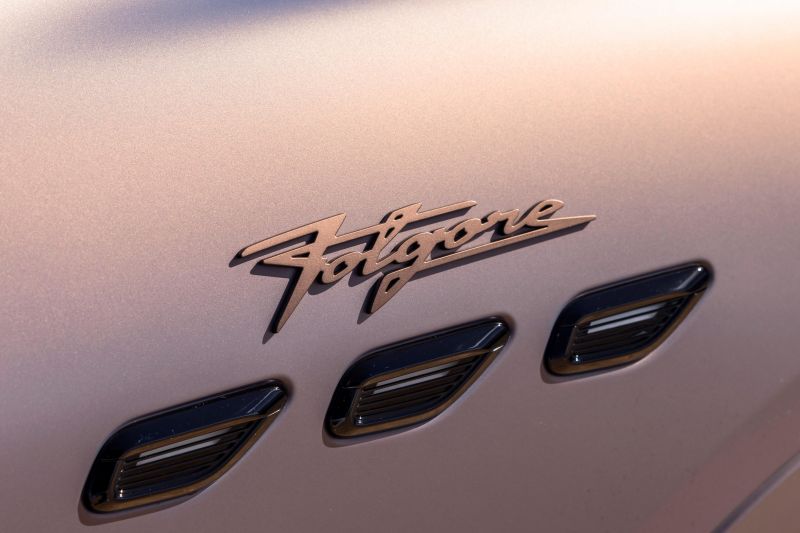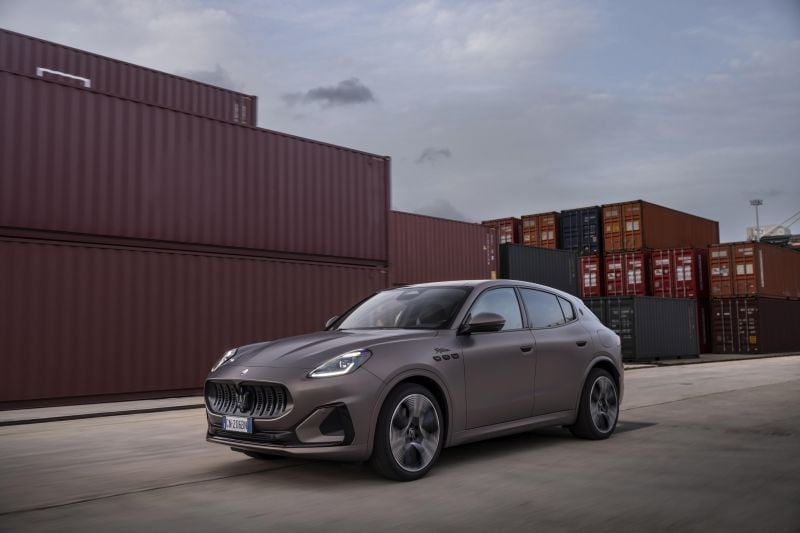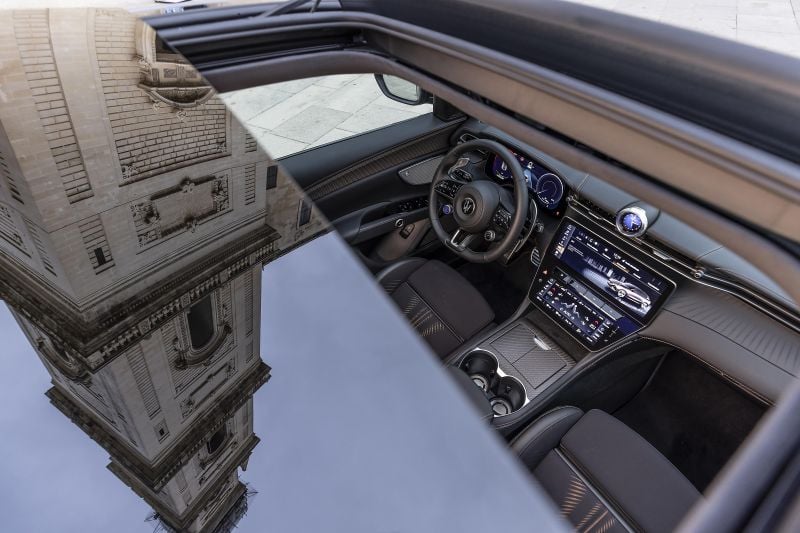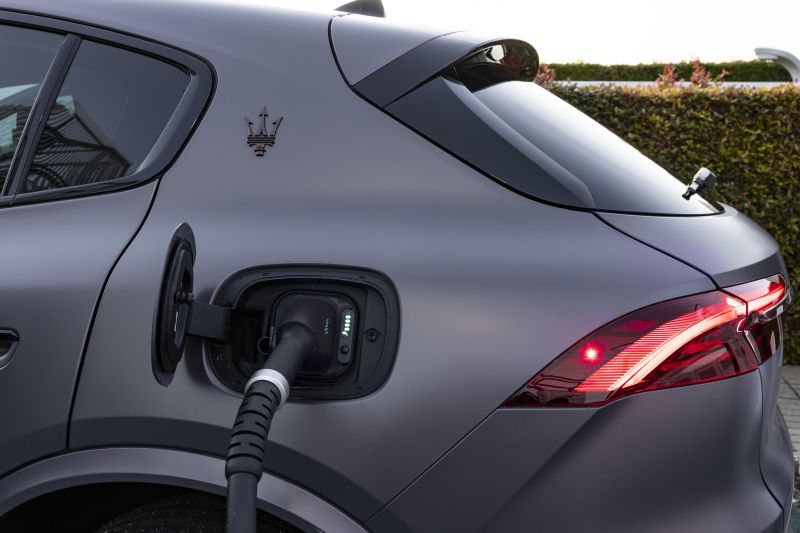The Maserati Grecale Folgore is Maserati’s first ever electric-powered SUV – Folgore means lightning in Italian, and you’ll soon see the word on every new model carrying the famed trident badge.
That’s because even as some carmakers are quietly backing away from claims they’ll be producing nothing but EVs by 2030, Maserati is doubling down on its race to electrification. Company sources are now saying the last Maserati powered by an internal combustion engine will roll off the assembly line in 2028.
Internal combustion engined versions of the Grecale were launched in 2022, and while insiders wouldn’t spell it out at the time, this mid-sized Maserati SUV was clearly aimed at Porsche’s popular Macan. And just as the Macan has become Porsche’s best-selling model worldwide, the Grecale is now Maserati’s money-spinner, accounting for 70 per cent of its sales.
The Grecale Folgore therefore has very big shoes to fill. If Maserati sticks with its ambitious timetable, within five years it will need to be the company’s volume seller, earning profits that can help fund the development of the next-generation of electric-powered Maserati sports cars and grand tourers. It must also go head-to-head with Porsche’s all-new Macan Electric.
No pressure, then.
Unlike the Macan Electric, which shares not a single exterior panel or dimension with its combustion engined cousins, the Folgore looks all but identical to petrol-powered Grecale models – the differences are in the details.
The iconic Maserati grille has been cleverly reworked, the vertical bars transformed into vertical vents that cool the electric powertrain components. The large vents in the front bumper have body-coloured infills, as do the indents in the rear bumper designed to accommodate the quad exhaust outlets of the V6-powered Grecale Trofeo.
The signature porthole vents on the front quarter panels remain, but instead of venting air they now light up when you unlock the car.
Unique to the Grecale Folgore is the striking optional matte copper-grey colour called Rame Folgore you see here. Regardless of which exterior colour you choose most of the car’s badging is copper-coloured – we’re sensing a theme here – though the Maserati trident in the grille remains chrome. The Folgore also gets unique, aero-optimised alloy wheels.
Unlike the Macan Electric, which is built on a bespoke EV platform, the Grecale Folgore shares a lot of hardware under the skin with its internal combustion engine siblings, too.
It rolls on a modified version of the Giorgio platform that underpins the rest of the Grecale range, with cast and extruded aluminium subframes at the front and rear of the car cradling the e-motors and providing pickup points for the standard air suspension.
How does the Maserati Grecale compare?
View a detailed breakdown of the Maserati Grecale against similarly sized vehicles.

Maserati
Grecale
How much does the Maserati Grecale cost?
As the Maserati Grecale Folgore is not anticipated to go on sale in Australia until the fourth quarter of this year, Maserati has yet to announce pricing.
However, sources in Modena suggest the Folgore will be priced slightly above the Grecale Trofeo and the Porsche Macan Turbo Electric, which suggests it will retail for between $180,000 and $200,000 before on-road costs.
What is the Maserati Grecale like on the inside?
The Grecale Folgore’s styling, more concisely elegant than that of the larger Levante, flatters to deceive.
It might look like a mid-size SUV, but its 2903mm wheelbase is 10mm longer than that of the Macan Electric, and a hefty 96mm longer than that of the ICE Macan.
In addition, Maserati engineers have been able to package the Folgore’s 105kWh battery pack under the floor while retaining the same seating position as the ICE Grecale. What all that adds up to is a remarkably spacious interior that can accommodate four 182cm adults and carry their luggage in the boot.
The Grecale Folgore is not only surprisingly roomy inside, but the cabin has a touch of unmistakably Italian fashionista flair to it.
There’s a unique embossed pattern on the dash and distinctive copper-accented carbon interior trim. The 14-way sports seats are trimmed in fabric made from recycled nylon fish nets and have laser-etched details.
Like the other Grecales, the Folgore also has an impressive array of screens. The instrument panel is a configurable screen.
Above the centre console is a structure that houses a 12.3-inch touchscreen that controls the nav, audio, phone, and vehicle settings; below it is an 8.8-inch touchscreen that controls comfort functions such as the climate control and seat heating and cooling, as well as audio volume.
The two screens are behind a single surface that kinks from the near-vertical alignment of the upper screen to an angle that matches the upward sweep of the centre console for the lower screen. Separating the two screens are push-button transmission controls.
The clock at the centre of the upper dash is also a screen, which can be configured between classic analog and digital time displays, and to show performance data such as G-loads
What’s under the bonnet?
The Grecale Folgore is driven by 205kW permanently excited synchronous magnet e-motors mounted at the front and rear axles to deliver all-wheel drive – total output is therefore 410kW, with 820Nm of instant-on torque also available the moment you squeeze the accelerator pedal.
The e-motors are powered by a 105kWh battery made up of 33 six-cell modules, some of which are stacked under the rear seat. The usable capacity of the battery is 96kWh, which Maserati claims gives the Grecale Folgore a 500km range on the WLTP test cycle, assuming an average consumption of 24kWh/100km.
On paper that all looks reasonable, though not class leading. However, despite rumours the Grecale Folgore would have an 800V electrical architecture, it is built around 400V hardware.
That means slower charging than a Porsche Macan Electric or even Hyundai’s Ioniq 5 and Kia’s EV6, which boast 800V hardware and whose batteries can be taken from a 10 per cent state of charge to 80 per cent in 22 minutes or less.
While the Grecale Folgore’s battery will accept charge rates of up to 150kW on a fast charger, it needs 29 minutes to be taken from a 20 per cent state of charge to 80 per cent, and there’s a curious double whammy behind those numbers.
Maserati recommends that to prolong the battery’s life, it should be topped up when its state of charge drops to 20 per cent, rather than the 10 per cent commonly quoted as optimum by most other EV manufacturers.
That narrower recommended operating window suggests the Grecale Folgore will need to be plugged in more often, which may be why it comes standard with a 22kW on-board charger and Maserati will also supply and install a 22kW wall box charger in your garage at no extra cost.
How does the Maserati Grecale drive?
As you’d expect from an electric-powered SUV with the sort of grunt that used to be the calling card of a high-end HSV Commodore, the Grecale Folgore feels effortlessly quick in a straight line.
Maserati says it will swoosh from 0 to 100km/h in 4.1 seconds, and from 0 to 200km/h in 16.1 seconds, on the way to a claimed top speed of 220km/h.
However, the Grecale Folgore doesn’t kick you in the kidneys like Porsche’s Macan Turbo Electric, which can rustle up 470kW using overboost and pumps out a stonking 1130Nm of torque, enabling it to storm to 100km/h in just 3.3 seconds and to a top speed of 260km/h.
It’s also slower than the Trofeo, which gets to 100km/h in 3.8 seconds and to a top speed of 285km/h to the accompanied by a glorious snarl from the twin-turbo 3.0-litre Nettuno V6 it shares with Maserati’s mid-engined MC20.
There’s some speed, but not much emotion. Throw some corners into the mix, and the Grecale Folgore starts to feel much less effortless.
Four drive modes are available. The default startup mode is GT. Sport mode stiffens the suspension, lowers the ride height 15mm, and noticeably sharpens the response to the accelerator.
MaxRange mode does exactly what it says, dialling back the accelerator response, limiting the top speed to 130km/h and reducing the climate control system’s power to conserve energy and boost range. Offroad mode raises the ride height 20mm above the GT setting.
Drivers can also adjust the level of regen via paddles behind the steering wheel. Toggling the right paddle reduces regen, flicking the left increases it. The default setting, D, delivers lift-off deceleration roughly equivalent to that of an internal combustion engine vehicle with an automatic transmission.
D-minus increases the rate of deceleration to 0.1g, and D-double minus takes it to 0.2g, which enables one-pedal driving. D-plus eliminates regen altogether, allowing the Grecale Folgore to coast when you lift off the throttle.
Our test cars were on the optional 21-inch alloy wheels with 255/40 Pirelli P Zeros at the front and 295/35 items at the rear. Even in GT mode the primary ride is firm, and the Pirellis communicated every crevice and notch of the roads on our test route through southern Puglia, in Italy’s heel.
Getting ambitious with the accelerator also occasionally induced noticeable torque steer on uneven surfaces. Sport mode firmed up the ride even more, inducing plenty of sharp vertical motions through the cabin that increased as speeds rose.
The Grecale Folgore’s ride is brittle, a complete contrast to the Grecale Trofeo, which rolls and pitches noticeably, but whose motions are always well controlled and whose suspension gives you the support you want when you really lean on the performance.
“We wanted the car to communicate its dynamics,” said Maserati validation engineer Frederico de Medio of the Grecale Trofeo. Maserati’s approach, he claimed, repudiated the German obsession with stiffness. “Too many cars today are too rigid.”
It would be fascinating to hear what de Medio makes of the Grecale Folgore.
We suspect its stiff suspension is all about attempting to manage its mass, a byproduct of the fact that at 2480kg the Folgore weighs 23 per cent more than the Trofeo.
Complicating matters is steering which, though accurate, doesn’t provide much feedback, and an inert brake pedal that makes precise modulation of brake efforts difficult.
Speaking of which, if you left foot brake, the powertrain control system won’t let you squeeze the accelerator as you simultaneously come off the brake; in fact, it aggressively cuts the power, showing you a finger-wagging warning message on the dash, as it leaves the Grecale Folgore wallowing.
After a bit of experimentation, we found selecting Sport mode, pressing the button in the middle of the mode selector dial under the right hand spoke of the steering wheel to knock the spring and dampers back to the softer GT settings, and reducing the regen to zero made the Grecale Folgore feel more composed when driven briskly.
Among other things, the lack of regen makes the response to accelerator inputs much smoother. Even so, the Grecale Folgore never feels as coherent as the V6 Trofeo, or as comfortable as the four-cylinder GT and Modena models
What do you get?
Maserati Australia hasn’t released full details on the Grecale Folgore’s final specification, as yet.
Standard equipment will likely include:
- 12.3-inch digital instrument cluster
- 12.3-inch touchscreen infotainment system
- 21-inch alloy wheels
- 14-way power sports front seats
- Dual zone climate control
- Electrically adjustable steering column
- Head-up display
- Maserati Intelligent Assistant powered by Android Auto
- Sonus Faber 21-speaker audio system
- Wireless Apple CarPlay, Android Auto
Is the Maserati Grecale safe?
The Maserati Grecale Folgore has yet to be rated by ANCAP or Euro NCAP
Standard safety equipment includes:
- Autonomous emergency braking (AEB)
- Adaptive cruise control
- Blind-spot monitoring
- Lane keep assist
- Traffic sign recognition
- Stability control
How much does the Maserati Grecale cost to run?
Maserati covers all its models with a three-year, unlimited-kilometre warranty, which is the same as what Porsche offers for its range, but less than Audi, BMW and Mercedes-Benz – all of which offer five-years.
CarExpert’s Take on the Maserati Grecale
The fabulous Maserati GranTurismo Folgore, whose state-of-the-moment 800V electric powertrain punches out 900kW and 1350Nm and delivers shattering straight-line speed and torque-vectored agility through the corners, proves Maserati can build an electric car worthy of the traditions of the famous trident badge.
The Grecale Folgore isn’t as convincing. Of course, it’s a much less expensive electric Maserati than the luscious GranTurismo Folgore.
But that doesn’t excuse things the 400V architecture, the narrower battery operating window, and the fact it doesn’t drive with the relaxed brio you expect of a Maserati when pushed. These things make the Grecale Folgore feel oddly compromised; especially in the context of the new Porsche Macan Electric.
The Grecale Folgore has more power and torque than the entry-level Macan 4 Electric, and is a full 1.5 seconds quicker to 100km/h. The similarly priced Macan Turbo Electric absolutely packs more outright performance, and enthusiast drivers will find it more playful and responsive.
The good news is the Maserati’s foibles can be easily fixed with reworked spring and damper rates, and tweaks to the powertrain software. As the petrol-powered models show, the Grecale’s fundamentals are pretty good.
And the Grecale Folgore does have its strong points, most of which you can see. It’s roomy inside and has levels of standard equipment that would add thousands to the price of a Macan (get carried away on the configurator and you can end up with a Turbo Electric that costs the best part of $250,000).
Most of all, it’s unmistakably a Maserati, from its high-style interior to that iconic grille with its trident badge glittering front and centre.
Click the images for the full gallery
MORE: Buy a Maserati Grecale
MORE: Everything Maserati Grecale

